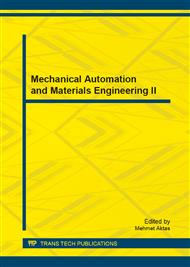p.501
p.506
p.511
p.519
p.524
p.529
p.534
p.539
p.544
Decoupling Control for Bearingless Synchronous Reluctance Motor Based on Fuzzy Inverse Model
Abstract:
For the bearingless synchronous reluctance motor (BSRM) is a multivariable, strong coupling, multi-input and multi-output system, based on the adaptive inverse control theory, a decoupling control method based on the T-S fuzzy inverse model identification is put forward in this paper. According to the input and output information of the system, a fuzzy inverse model of the motor control system is established, then making the inverse model and the original control system in series forms pseudo linear hybrid system to realize the approximate linearization and dynamic decoupling of the motor control system. Building the composite system and proceeding research in the Matlab/Simulink environment, the simulation results show that the control strategy can realize dynamic decoupling among the electromagnetic torque subsystem and the radial suspension force subsystem and among the x- and y-direction of the suspension force, and with excellent static and dynamic performance and adaptive ability.
Info:
Periodical:
Pages:
524-528
Citation:
Online since:
June 2014
Authors:
Price:
Сopyright:
© 2014 Trans Tech Publications Ltd. All Rights Reserved
Share:
Citation:


